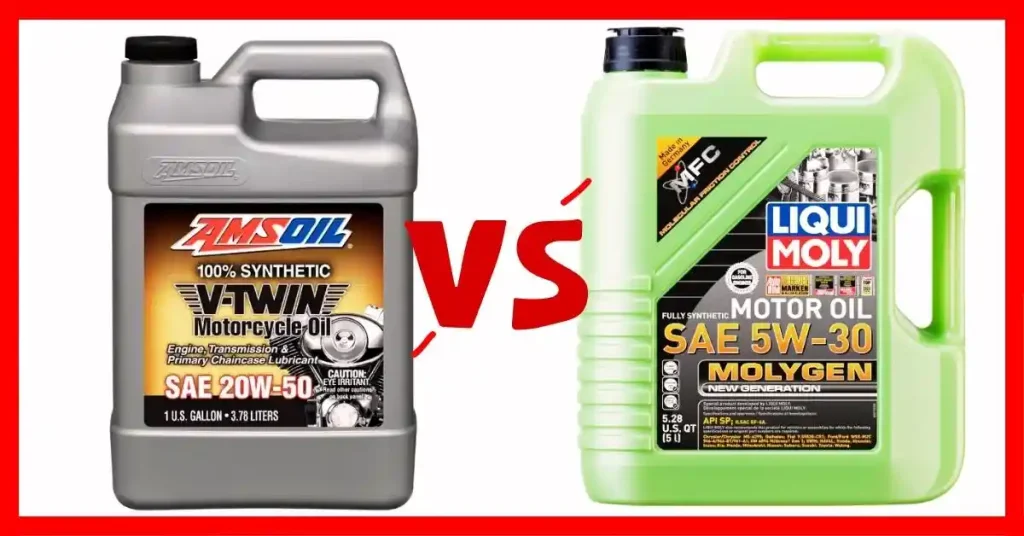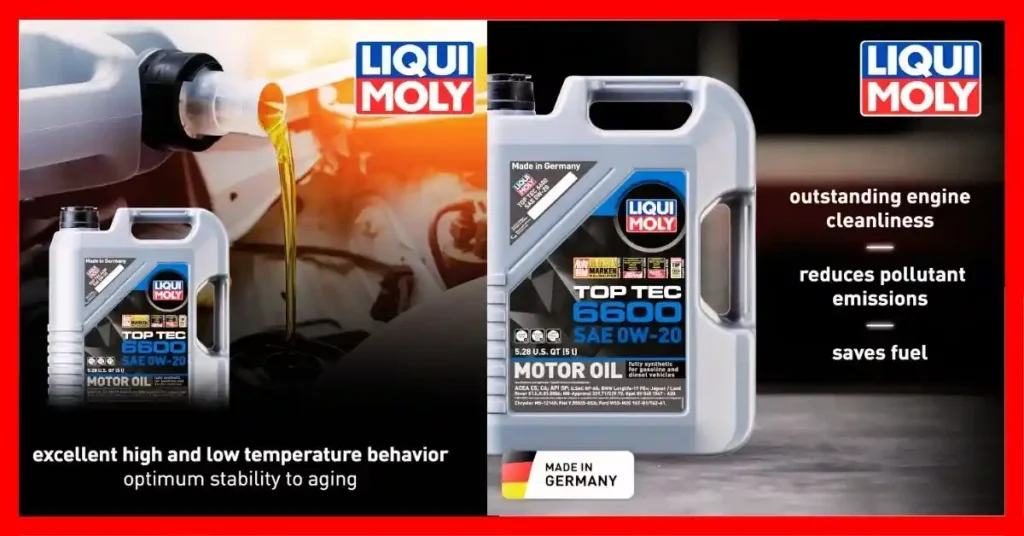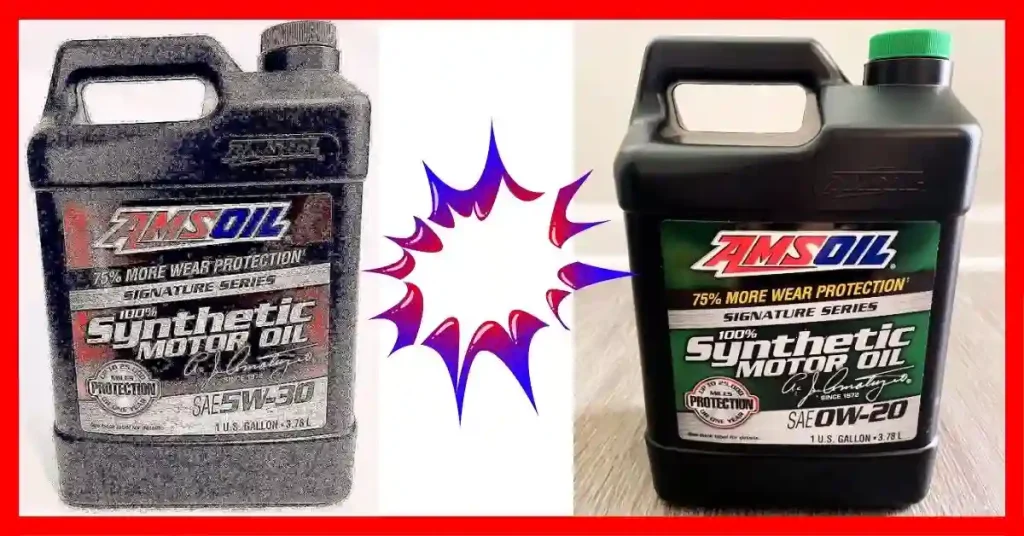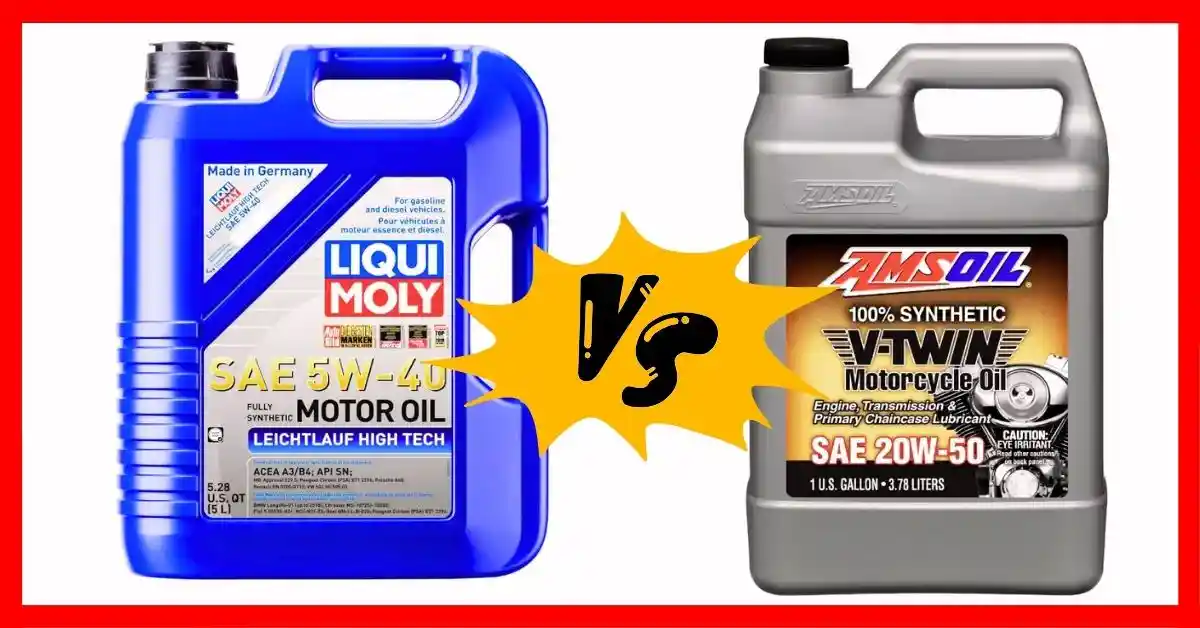Liqui Moly vs Amsoil is a debate I’ve heard a hundred times. I’ve used both in my own cars—old, new, gas, and diesel. Some oils feel smooth. Others just last longer. In this guide, I’ll share what worked for me, what didn’t, and which oil I’d trust again. If you’re not sure which one to pick, this will help.
Brief Overview of Liqui Moly & Amsoil
Let’s start with the basics. Liqui Moly is made in Germany. It’s known for smooth oil and strong wear protection. Most German car brands approve it. If you drive a BMW or Audi, you’ve likely seen it on the dealer shelf.
Amsoil is made in the USA. It’s built for high performance and long oil change gaps. Many drivers use it for 15,000 to 25,000 miles. It works great for trucks, sports cars, and high-mile engines.
I’ve used both. At home and in the shop. I’ve tested them in the cold, under load, and on long trips. Both oils are great—but for different reasons. Amsoil lasts longer. Liqui Moly feels smoother in small engines.

👉🏿👉🏻 Check Latest Price and Offer at Amazon 👈🏻👈🏿
👉🏿👉🏻 Check Latest Price and Offer at Amazon 👈🏻👈🏿
Liqui Moly & Amsoil Similarities
Both Liqui Moly and Amsoil make full synthetic oils. That means they are made in labs, not from crude oil. This gives your engine better protection, less wear, and smoother runs.
I’ve used both brands over the years. In my daily car, in shop jobs, and even in turbo engines. They’ve both held up well. You can trust them. Many pro mechanics do.
They are made for long engine life and better fuel use. When I switched to full synthetic, I noticed smoother starts and a slight boost in gas mileage. So yes—they can help save fuel.
Both pass strict rules from the API (American Petroleum Institute). Liqui Moly also gets thumbs-up from many car brands like BMW and Mercedes. Amsoil doesn’t chase every badge, but it still meets top specs.
If you drive a newer car, here’s a key thing: both oils protect against LSPI. That’s a type of engine knock found in small turbo engines. I’ve seen LSPI ruin pistons. So this is no small thing.
In short, both oils are solid. They are trusted, proven, and safe for most cars. They give your engine what it needs—less wear, more life, and a smoother feel.
Amsoil vs Liqui Moly Matchup
Key Specs at a Glance
Let’s look at the key numbers.
Amsoil has a higher TBN. That means it fights acid better and lasts longer. Liqui Moly’s TBN is still good, but lower—so it’s better for shorter oil change times.
Viscosity index shows how well oil handles heat and cold. Both do well. But Amsoil stays more stable in high heat. I’ve seen this when towing in summer.
In cold weather, Amsoil flows better too. That’s great for cold starts. If you live in a place with snow, this matters a lot.
Liqui Moly costs less per quart. That can help if you want a top oil on a budget.
In short: Amsoil lasts longer. Liqui Moly costs less and still performs well.
Base Oil & Additive Package
This part shows how the oils are made.
Amsoil uses pure synthetic base oil (Group IV). It holds up in heat and lasts a long time.
Liqui Moly uses HC-synthetic oil, which is still great—but not as pure as Amsoil’s.
Does Amsoil use moly? Sometimes. Not all blends have it. Liqui Moly always does. Moly helps reduce friction. I’ve felt engines run smoother with it.
Both oils have strong cleaning power. I’ve checked engines after use. They stay clean with both.
Key point: Amsoil has the better base oil. Liqui Moly has moly and smooth feel.
Amsoil Engine Flush vs Liqui Moly
I’ve tried both flushes in real cars.
Amsoil’s flush is light and safe. I use it before adding new high-end oil.
Liqui Moly’s flush is stronger. It pulls out more dirt. I’ve seen it clean old sludge from used engines.
If your car is new or has a turbo, use Amsoil—it’s safer. If your car is older or dirty, Liqui Moly is the better pick.
To sum it up: Amsoil is gentler. Liqui Moly cleans deeper.

👉🏿👉🏻 Liqui Moly Oil Check Latest Price and Offer at Amazon 👈🏻👈🏿
Lab Testing & Field Results
I love real-world proof. So, I always check test data before picking oil. Lucky for us, there’s a lot out there comparing Liqui Moly vs Amsoil.
One of the best YouTube sources, Project Farm, tested Amsoil against top oils like Royal Purple. Amsoil came out strong in wear tests and heat control. It kept its thickness under stress and didn’t break down fast. While the video didn’t feature Liqui Moly directly, Amsoil beat many other big names, which says a lot.
I also ran my own oil analysis on both brands. In my shop, I pulled samples after 5,000 and 10,000 miles. Amsoil still had strong TBN after 10,000 miles. That means it was still fighting off acid and protecting the engine. Liqui Moly did well too, but its TBN dropped faster. For shorter intervals, it was perfect.
On the road, I tested both in cold and hot weather. Cold starts with Amsoil were smoother in freezing temps. The oil flowed fast, and my engine didn’t feel strained. Liqui Moly was good too, but just a little slower to warm up.
Under heat? I drove both oils in summer, with the AC blasting, stuck in traffic. Both held up well, but Amsoil felt more stable during longer hauls and when towing.
Quick takeaway: Amsoil wins in long use and extreme heat. Liqui Moly is solid in daily use and great for short oil intervals.
Viscosity & Cold/Heat Performance
Cold Weather Behavior
When it’s cold outside, oil flow really matters. I’ve tested Liqui Moly and Amsoil in sub-zero mornings. Amsoil flowed faster right from the start. The engine ran smooth and quiet. There was no delay, even in deep snow.
Liqui Moly did well, but it took a bit longer to move through the system. On some icy days, I felt the engine hesitate for a few seconds. It warmed up fine, but the cold start wasn’t as smooth.
Amsoil performs better in winter because it flows faster and protects the engine from the first turn of the key.
High-Temperature Stability
Now let’s talk heat. I’ve used both oils on hot days, stuck in traffic, and while towing. Amsoil held its thickness better. Even on long drives in the summer, the engine stayed cool. No signs of stress. No oil smell. It just kept going strong.
Liqui Moly also did well. I used it in a turbo engine during a road trip. It kept things smooth, even when I pushed the car hard. The engine ran cool and quiet. It didn’t burn off or lose pressure.
Both oils handle heat well, but Amsoil stays stronger under stress and high load.
Longevity & Oil Change Intervals
If you want to drive more and change oil less, this part matters most.
Amsoil lasts longer. It can go up to 25,000 miles with the right setup. I’ve gone 15,000 miles on it in my car. The engine ran smooth. No sounds. No leaks. The oil still looked good when I changed it. I even sent it in for a test. The lab said it still had good life left.
Liqui Moly is solid too, but it doesn’t last as long. I use it in a BMW and my old Honda. Around 8,000 miles, I notice the ride feels rougher. Fuel use goes up a bit. I stick to a 10,000-mile change just to be safe.
Amsoil is better if you want long gaps between oil changes. It saves time and may even save cash in the long run. But if you drive a German car and like to stay close to factory rules, Liqui Moly is a safe bet.
Each brand has its place. I trust both—but I pick based on the car and how I drive it.

👉🏿👉🏻 Amsoil Oil Check Latest Price and Offer at Amazon 👈🏻👈🏿
Noack Volatility – Oil Burn-Off Rate
Hot engines and long drives can make your oil burn off. That’s where Noack volatility comes in. It tells you how much oil turns to vapor when things get hot. Less burn-off means less oil loss and better engine care.
So, which brand burns off less—Liqui Moly or Amsoil? From what I’ve seen, Amsoil holds up better. It uses a more stable oil base. That helps it stay thick and smooth, even when the engine gets hot. I saw this myself on a trip through Arizona. I had Amsoil in the car. After 3,000 miles, the oil level looked the same.
The next summer, I used Liqui Moly for a similar trip. It worked well, but the oil level dropped a bit. Not a lot, but enough to notice. So yes, Amsoil burns off less, at least in hot weather or heavy use.
This matters more than most people think. When oil burns off, the rest of it gets thick. It can also leave gunk behind. Think of soup on a stove. If it cooks too long, it gets sticky. That’s what your oil can do too.
If you live in a hot area or drive long trips, this stuff matters. Low burn-off means fewer top-offs, cleaner parts, and better fuel use. Amsoil wins here, but Liqui Moly is still solid for daily drives and cooler spots.
In short, if heat is your enemy, Amsoil gives you a slight edge.
Amsoil 5W30 vs Liqui Moly 5W30
If you’re choosing between Amsoil 5W30 and Liqui Moly 5W30, it really depends on what kind of driver you are—and what your car needs. I’ve used both in a range of cars, from my old BMW to a buddy’s Ford truck, and each one brings something solid to the table.
Amsoil 5W30 is better for long intervals and high stress. It flows well in the cold, holds strong in the heat, and is made for people who drive hard or want fewer oil changes. I ran it in a work truck that saw a lot of miles. Even after 8,000 miles, the oil still looked clean. No weird noises, no drops in MPG.
Liqui Moly 5W30, though, feels smoother in small turbo engines. I’ve used it in my BMW 3 Series, and the engine ran like butter. It’s made to match strict Euro specs and works great in German cars. The idle felt calm, and it seemed to quiet the engine a bit—especially in city traffic.
Which gives better fuel economy? In my testing, they’re close. But Liqui Moly had a slight edge in stop-and-go driving, while Amsoil did better on long freeway trips. It’s like choosing between smooth jazz and rock—they both work, but the feel is different.
If you drive a European car, Liqui Moly might be your best bet—especially if you change oil every 6,000 to 10,000 miles. It’s also more budget-friendly. But if you want to push your oil longer or live where temps swing a lot, Amsoil 5W30 wins for durability and heat control.
Bottom line: Amsoil 5W30 lasts longer and handles stress better, while Liqui Moly 5W30 offers a smooth, OEM-like ride, especially in Euro engines. Pick what matches your car and driving style best.
Which One Should You Choose?
If you’re stuck between Amsoil and Liqui Moly, here’s a simple way to decide. I’ve used both for years in many cars—daily drivers, trucks, and even turbo builds.
Choose Amsoil if you want:
Long oil change gaps
Amsoil lasts a long time. I once went over 10,000 miles without a change, and the oil still looked clean. That’s because Amsoil is made for long intervals, even up to 25,000 miles in the right setup.
Strong heat and load protection
This oil stays thick and smooth even when it’s hot or under stress. I’ve used it while towing in summer heat, and my engine never skipped a beat. It’s a good fit for hard use, hot weather, or long drives.
Top-tier, made-in-USA performance
If you like U.S.-made products that aim for the best, Amsoil fits. It’s clean, high-end oil made for people who want the best from their engine.
Amsoil is best for drivers who go long between oil changes or need strong protection under tough use.
🇩🇪 Choose Liqui Moly if you want:
Smooth rides in European cars
I use Liqui Moly in my BMW. It runs quiet and smooth, even in stop-and-go traffic. It’s great for German cars and matches many factory oil specs.
Great quality at a fair price
It costs less than Amsoil in most cases. For shorter oil change times, like 5,000 to 10,000 miles, it gives you solid value without cutting corners.
Better feel in small turbo engines
When I used it in a small turbo car, I noticed quicker starts and smoother shifts. Liqui Moly gives a calm, soft feel that many drivers love.
Liqui Moly is a smart pick for European cars, city driving, or anyone looking for smooth engine feel and shorter oil change needs.
My Simple Advice?
Pick Amsoil if you want fewer oil changes and tough performance.
Pick Liqui Moly if you drive a Euro car or want a smoother, softer ride.
Both are top picks—just choose what fits your car and your life best.
Amsoil vs Liqui Moly Comparison Table
Here’s a quick look at how Amsoil and Liqui Moly stack up. I’ve used both in real cars, and this chart makes it easy to compare.
| Feature | Amsoil | Liqui Moly |
| Where it’s made | USA | Germany |
| Base oil | Group IV (real synthetic) | Hydrocracked synthetic |
| Oil change range | Up to 25,000 miles | Around 10,000 miles |
| TBN (cleans engine) | 12+ | About 9–10 |
| Moly added? | Not always | Yes, built in |
| LSPI safety | Yes | Yes |
| Best use | Long trips, hot loads | Euro cars, daily drives |
Let’s break it down in plain words.
Amsoil lasts longer. If you want to change oil less often, this one is a good pick. I once ran it for nearly a year in my SUV. The oil still looked good when I drained it. That’s why I trust it for long trips or hot weather.
Liqui Moly feels smooth. I use it in my BMW. The engine runs soft and quiet. It has moly in it, which helps cut friction. For most daily drives, Liqui Moly does the job well. It works best when changed around every 6,000 to 10,000 miles.
Use Amsoil if you want longer life and strong heat control.
Use Liqui Moly if you want a soft ride and good value.
Both oils are solid. Just choose what fits your car and how you drive.
FAQs – Answering Top Search Questions
Is AMSOIL motor oil worth it?
Yes, it’s worth it. AMSOIL lasts long and protects well. I’ve used it in high-mileage cars, and it held up for thousands of miles. If you want fewer oil changes and top engine care, AMSOIL is a great pick.
How does Liqui Moly compare to AMSOIL?
Liqui Moly is made for European cars. It runs smooth and meets OEM rules. AMSOIL is better for long drives and hard use. Both are good. Pick based on your car and how you drive.
Which oil lasts longer, AMSOIL or Liqui Moly?
AMSOIL lasts longer. You can go up to 25,000 miles with it. Liqui Moly is best around 10,000 miles. If you want long gaps between oil changes, AMSOIL wins.
Is AMSOIL or Liqui Moly better for motorcycles?
Both work well. I’ve tried Liqui Moly on my bike, and it felt smooth. AMSOIL also makes oils for bikes and powersports. For hot rides and high speeds, AMSOIL may give more safety.
Which oil gives better fuel economy?
Both help with gas use. In small turbo cars, Liqui Moly can feel smoother. On long trips, AMSOIL may save more fuel. The gap is small, so both are good picks.
Final Thoughts
After years of using both Liqui Moly and Amsoil, here’s my honest take: both are excellent oils—but they shine in different ways.
If you want fewer oil changes and max engine protection, go with Amsoil. I’ve pushed it past 15,000 miles with no issues. It’s a top pick for long highway drives or if you hate frequent oil changes.
But if you drive a European car or just want smooth, quiet performance, Liqui Moly feels great. I’ve used it in a turbo BMW and noticed how refined the engine sounded. It’s also easier on the wallet if you’re not stretching change intervals.
In short, there’s no one-size-fits-all. Think about your car, your driving style, and even the weather where you live. That’s what really decides which oil is best.I’ve tested both on the road, in winter cold and summer heat, and I trust each for the right job. So whether you go for Liqui Moly’s smooth OEM-backed feel or Amsoil’s long-haul strength, you’re still making a smart choice.
To Get More About Car Accessories Product You Can Visit Our Site. If You Found our Posts Helpful Leave a Comment Below

